bulb BMW 6 SERIES CONVERTIBLE 2016 F12 Owner's Manual
[x] Cancel search | Manufacturer: BMW, Model Year: 2016, Model line: 6 SERIES CONVERTIBLE, Model: BMW 6 SERIES CONVERTIBLE 2016 F12Pages: 259, PDF Size: 7.85 MB
Page 79 of 259
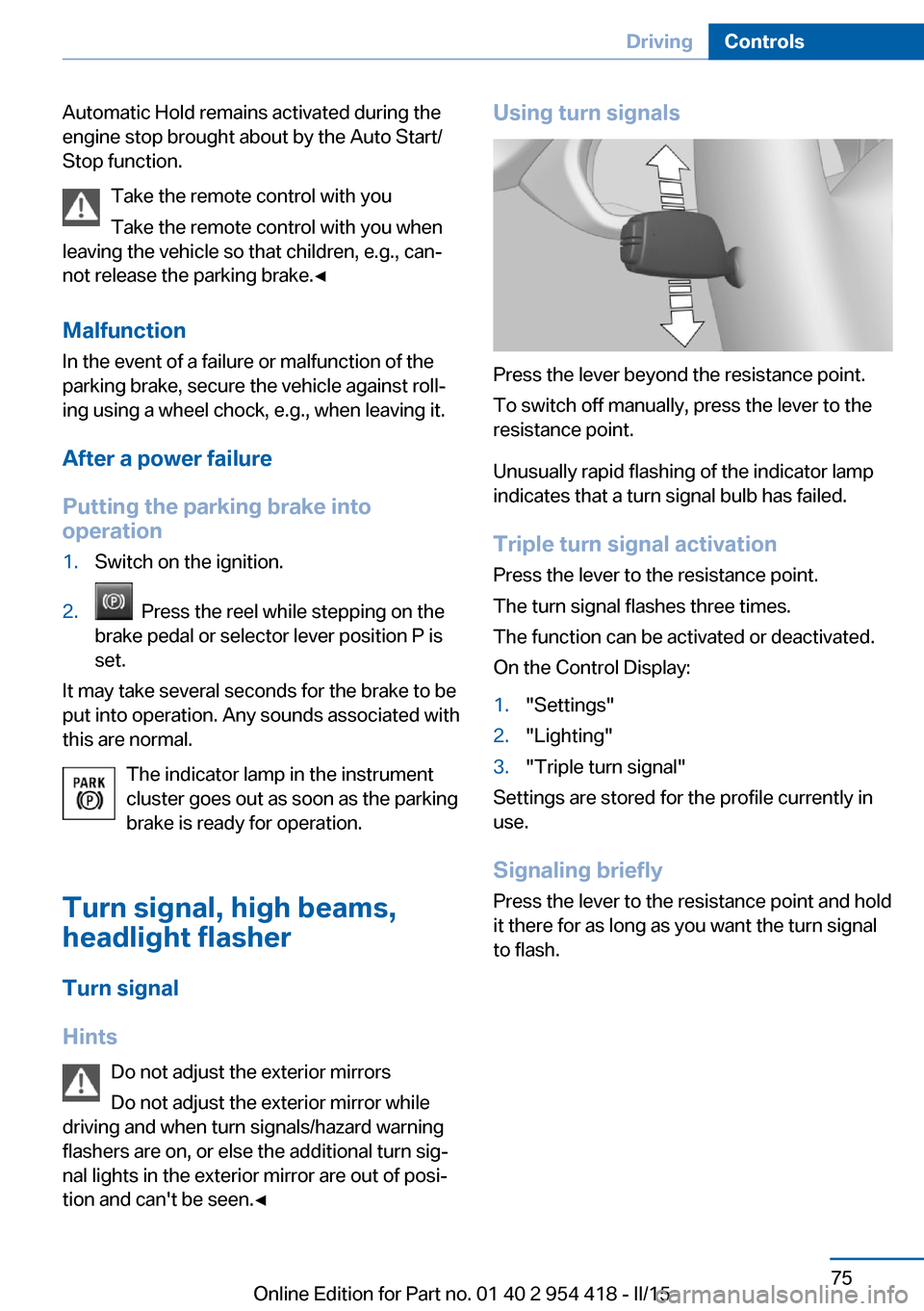
Automatic Hold remains activated during the
engine stop brought about by the Auto Start/
Stop function.
Take the remote control with you
Take the remote control with you when
leaving the vehicle so that children, e.g., can‐
not release the parking brake.◀
Malfunction
In the event of a failure or malfunction of the
parking brake, secure the vehicle against roll‐
ing using a wheel chock, e.g., when leaving it.
After a power failure
Putting the parking brake into
operation1.Switch on the ignition.2. Press the reel while stepping on the
brake pedal or selector lever position P is
set.
It may take several seconds for the brake to be
put into operation. Any sounds associated with
this are normal.
The indicator lamp in the instrument
cluster goes out as soon as the parking
brake is ready for operation.
Turn signal, high beams,
headlight flasher
Turn signal
Hints Do not adjust the exterior mirrors
Do not adjust the exterior mirror while
driving and when turn signals/hazard warning
flashers are on, or else the additional turn sig‐
nal lights in the exterior mirror are out of posi‐
tion and can't be seen.◀
Using turn signals
Press the lever beyond the resistance point.
To switch off manually, press the lever to the
resistance point.
Unusually rapid flashing of the indicator lamp
indicates that a turn signal bulb has failed.
Triple turn signal activation Press the lever to the resistance point.
The turn signal flashes three times.
The function can be activated or deactivated.
On the Control Display:
1."Settings"2."Lighting"3."Triple turn signal"
Settings are stored for the profile currently in
use.
Signaling briefly
Press the lever to the resistance point and hold
it there for as long as you want the turn signal
to flash.
Seite 75DrivingControls75
Online Edition for Part no. 01 40 2 954 418 - II/15
Page 93 of 259
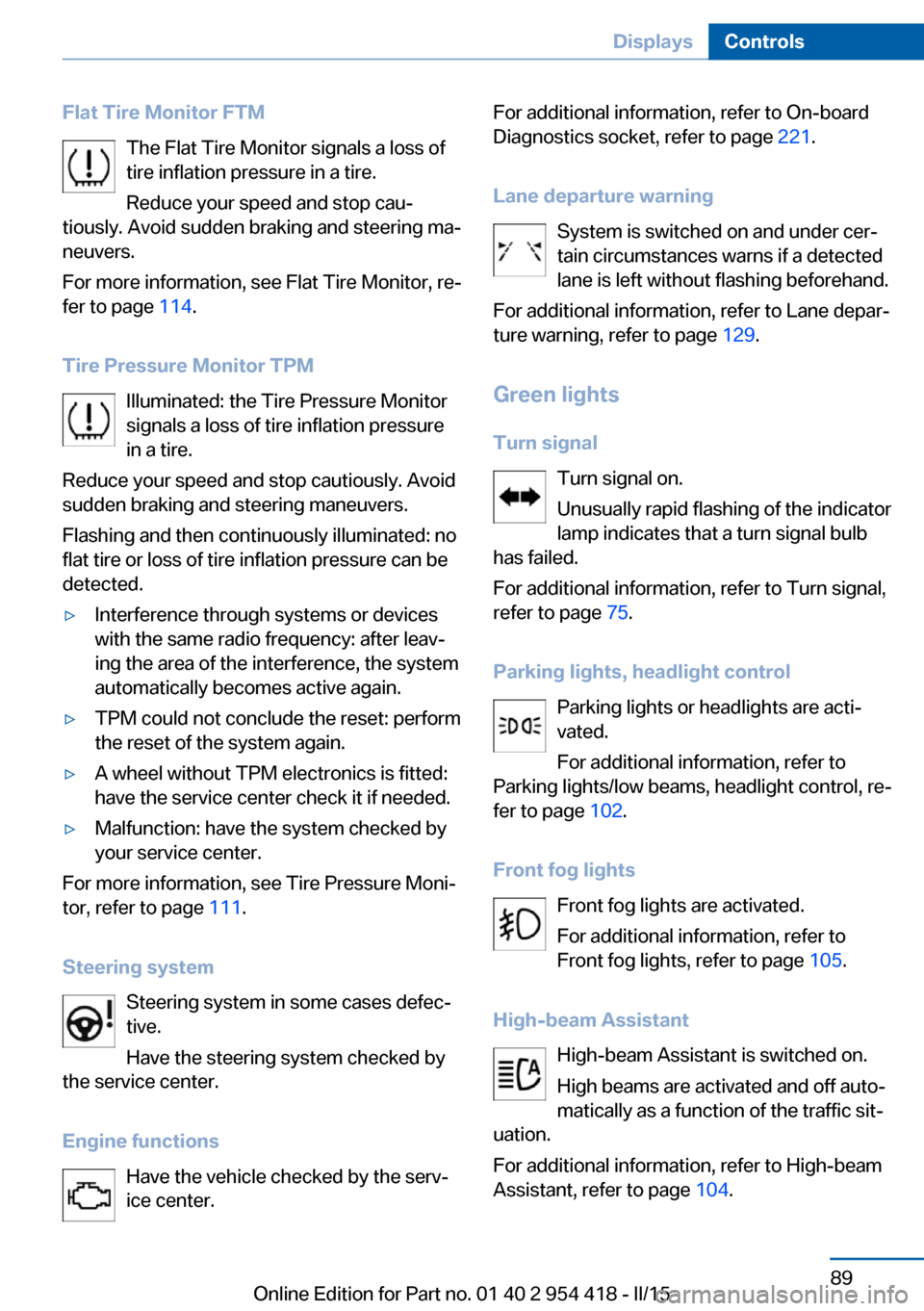
Flat Tire Monitor FTMThe Flat Tire Monitor signals a loss of
tire inflation pressure in a tire.
Reduce your speed and stop cau‐
tiously. Avoid sudden braking and steering ma‐
neuvers.
For more information, see Flat Tire Monitor, re‐
fer to page 114.
Tire Pressure Monitor TPM Illuminated: the Tire Pressure Monitor
signals a loss of tire inflation pressure
in a tire.
Reduce your speed and stop cautiously. Avoid
sudden braking and steering maneuvers.
Flashing and then continuously illuminated: no
flat tire or loss of tire inflation pressure can be
detected.▷Interference through systems or devices
with the same radio frequency: after leav‐
ing the area of the interference, the system
automatically becomes active again.▷TPM could not conclude the reset: perform
the reset of the system again.▷A wheel without TPM electronics is fitted:
have the service center check it if needed.▷Malfunction: have the system checked by
your service center.
For more information, see Tire Pressure Moni‐
tor, refer to page 111.
Steering system Steering system in some cases defec‐
tive.
Have the steering system checked by
the service center.
Engine functions Have the vehicle checked by the serv‐ice center.
For additional information, refer to On-board
Diagnostics socket, refer to page 221.
Lane departure warning System is switched on and under cer‐
tain circumstances warns if a detected
lane is left without flashing beforehand.
For additional information, refer to Lane depar‐
ture warning, refer to page 129.
Green lights Turn signal Turn signal on.
Unusually rapid flashing of the indicator
lamp indicates that a turn signal bulb
has failed.
For additional information, refer to Turn signal,
refer to page 75.
Parking lights, headlight control Parking lights or headlights are acti‐
vated.
For additional information, refer to
Parking lights/low beams, headlight control, re‐
fer to page 102.
Front fog lights Front fog lights are activated.
For additional information, refer to
Front fog lights, refer to page 105.
High-beam Assistant High-beam Assistant is switched on.
High beams are activated and off auto‐
matically as a function of the traffic sit‐
uation.
For additional information, refer to High-beam
Assistant, refer to page 104.Seite 89DisplaysControls89
Online Edition for Part no. 01 40 2 954 418 - II/15
Page 226 of 259

Replacing componentsVehicle features and optionsThis chapter describes all standard, country-
specific and optional features offered with the
series. It also describes features that are not
necessarily available in your car, e. g., due to
the selected options or country versions. This
also applies to safety-related functions and
systems. The respectively applicable country
provisions must be observed when using the
respective features and systems.
Onboard vehicle tool kit
The onboard vehicle tool kit is located under
the cargo floor panel.
Wiper blade replacement Hints Do not fold down the wipers without
wiper blades
Do not fold down the wipers if wiper blades
have not been installed; this may damage the
windshield.◀
Replacing the wiper blades1.To change the wiper blades, fold up, refer
to page 77, the wiper arms.2.Fold up the wipers.3.Position the wiper blade in a horizontal po‐
sition.4.Remove the wiper blade toward one side.5.Insert the new wiper blade in reverse order
of removal until it locks in place.6.Fold down the wipers.
Lamp and bulb replacement
Hints
Lights and bulbs
Lights and bulbs make an essential contribu‐
tion to vehicle safety.
The manufacturer of the vehicle recommends
that you entrust corresponding procedures to
Seite 222MobilityReplacing components222
Online Edition for Part no. 01 40 2 954 418 - II/15
Page 227 of 259
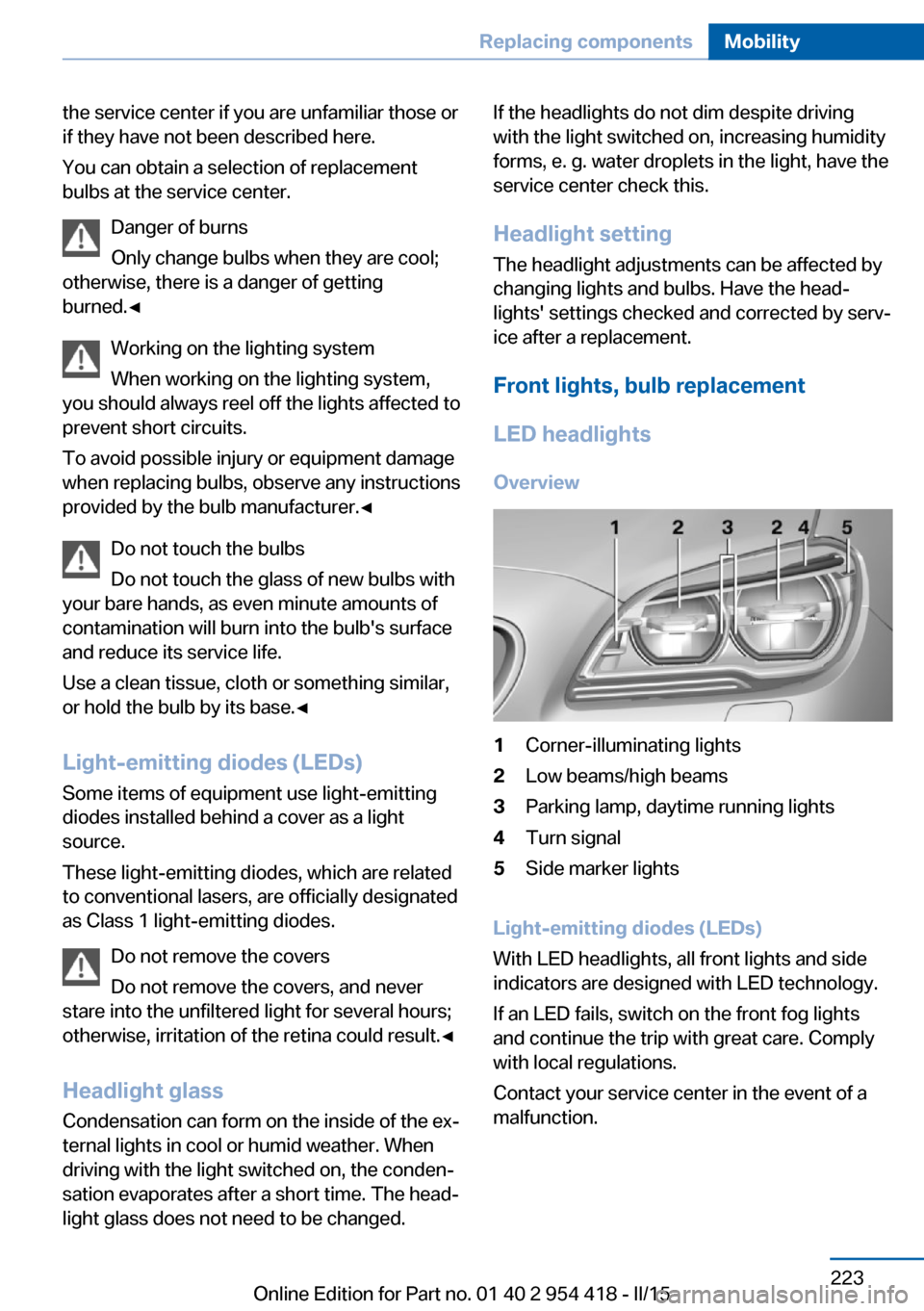
the service center if you are unfamiliar those or
if they have not been described here.
You can obtain a selection of replacement
bulbs at the service center.
Danger of burns
Only change bulbs when they are cool;
otherwise, there is a danger of getting
burned.◀
Working on the lighting system
When working on the lighting system,
you should always reel off the lights affected to
prevent short circuits.
To avoid possible injury or equipment damage
when replacing bulbs, observe any instructions
provided by the bulb manufacturer.◀
Do not touch the bulbs
Do not touch the glass of new bulbs with
your bare hands, as even minute amounts of
contamination will burn into the bulb's surface
and reduce its service life.
Use a clean tissue, cloth or something similar,
or hold the bulb by its base.◀
Light-emitting diodes (LEDs)
Some items of equipment use light-emitting
diodes installed behind a cover as a light
source.
These light-emitting diodes, which are related
to conventional lasers, are officially designated as Class 1 light-emitting diodes.
Do not remove the covers
Do not remove the covers, and never
stare into the unfiltered light for several hours;
otherwise, irritation of the retina could result.◀
Headlight glass
Condensation can form on the inside of the ex‐
ternal lights in cool or humid weather. When
driving with the light switched on, the conden‐
sation evaporates after a short time. The head‐
light glass does not need to be changed.If the headlights do not dim despite driving
with the light switched on, increasing humidity
forms, e. g. water droplets in the light, have the
service center check this.
Headlight setting The headlight adjustments can be affected by
changing lights and bulbs. Have the head‐
lights' settings checked and corrected by serv‐
ice after a replacement.
Front lights, bulb replacement LED headlights Overview1Corner-illuminating lights2Low beams/high beams3Parking lamp, daytime running lights4Turn signal5Side marker lights
Light-emitting diodes (LEDs)
With LED headlights, all front lights and side
indicators are designed with LED technology.
If an LED fails, switch on the front fog lights
and continue the trip with great care. Comply
with local regulations.
Contact your service center in the event of a
malfunction.
Seite 223Replacing componentsMobility223
Online Edition for Part no. 01 40 2 954 418 - II/15
Page 228 of 259
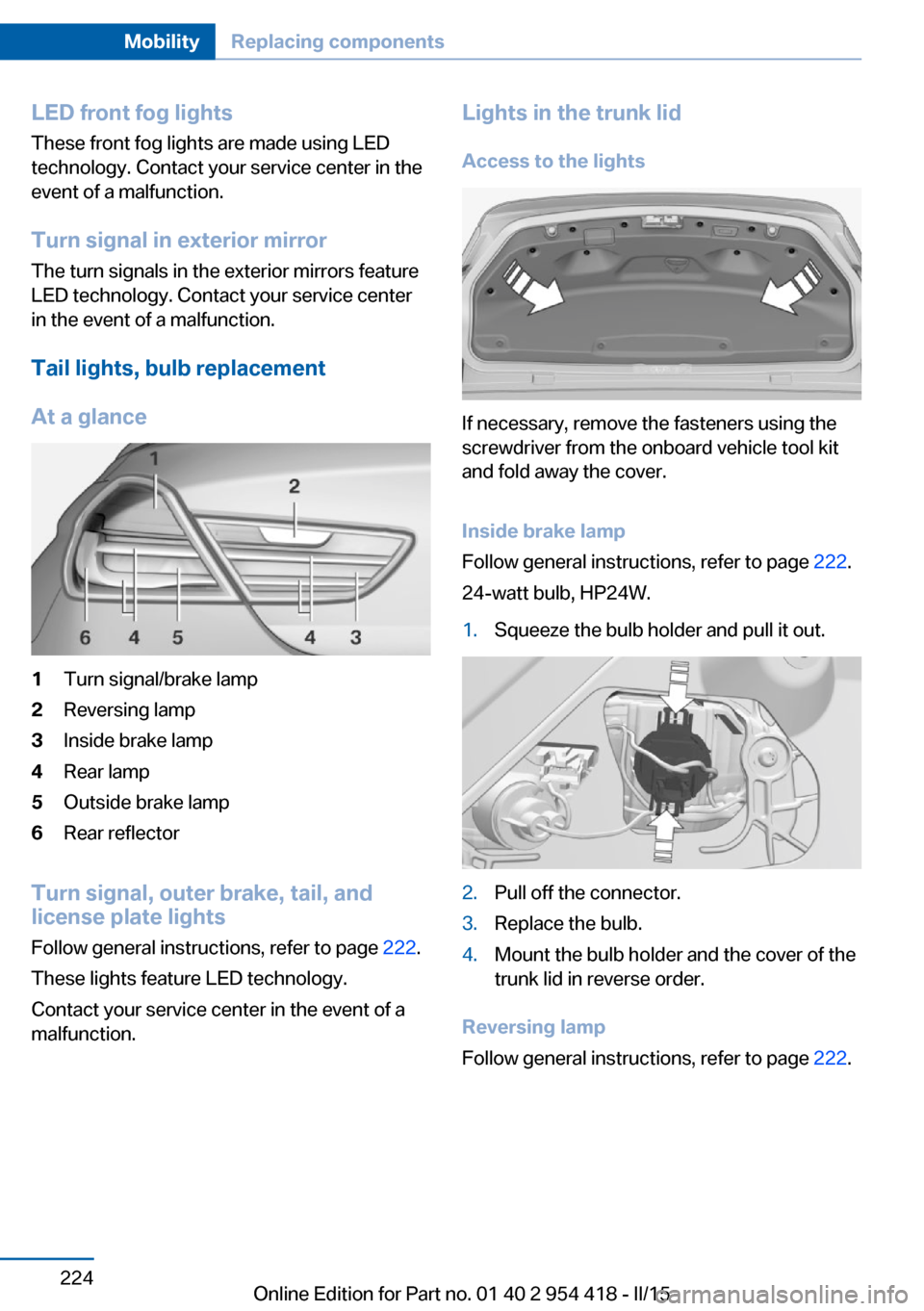
LED front fog lights
These front fog lights are made using LED
technology. Contact your service center in the
event of a malfunction.
Turn signal in exterior mirror The turn signals in the exterior mirrors feature
LED technology. Contact your service center in the event of a malfunction.
Tail lights, bulb replacement
At a glance1Turn signal/brake lamp2Reversing lamp3Inside brake lamp4Rear lamp5Outside brake lamp6Rear reflector
Turn signal, outer brake, tail, and
license plate lights
Follow general instructions, refer to page 222.
These lights feature LED technology.
Contact your service center in the event of a
malfunction.
Lights in the trunk lid
Access to the lights
If necessary, remove the fasteners using the
screwdriver from the onboard vehicle tool kit
and fold away the cover.
Inside brake lamp
Follow general instructions, refer to page 222.
24-watt bulb, HP24W.
1.Squeeze the bulb holder and pull it out.2.Pull off the connector.3.Replace the bulb.4.Mount the bulb holder and the cover of the
trunk lid in reverse order.
Reversing lamp
Follow general instructions, refer to page 222.
Seite 224MobilityReplacing components224
Online Edition for Part no. 01 40 2 954 418 - II/15
Page 229 of 259
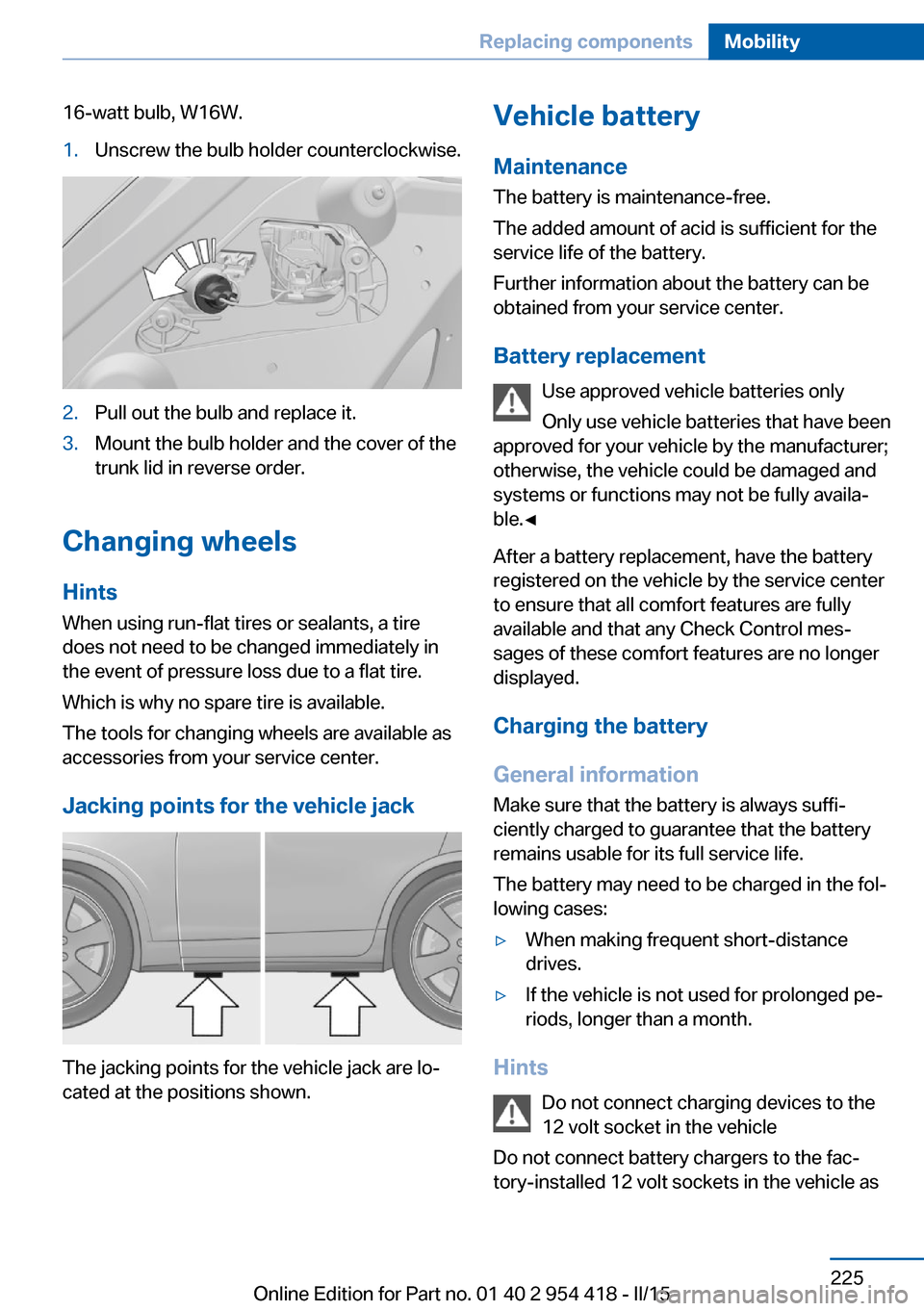
16-watt bulb, W16W.1.Unscrew the bulb holder counterclockwise.2.Pull out the bulb and replace it.3.Mount the bulb holder and the cover of the
trunk lid in reverse order.
Changing wheels
Hints
When using run-flat tires or sealants, a tire
does not need to be changed immediately in
the event of pressure loss due to a flat tire.
Which is why no spare tire is available.
The tools for changing wheels are available as
accessories from your service center.
Jacking points for the vehicle jack
The jacking points for the vehicle jack are lo‐
cated at the positions shown.
Vehicle battery
Maintenance
The battery is maintenance-free.
The added amount of acid is sufficient for the
service life of the battery.
Further information about the battery can be
obtained from your service center.
Battery replacement Use approved vehicle batteries only
Only use vehicle batteries that have been
approved for your vehicle by the manufacturer;
otherwise, the vehicle could be damaged and
systems or functions may not be fully availa‐
ble.◀
After a battery replacement, have the battery
registered on the vehicle by the service center
to ensure that all comfort features are fully
available and that any Check Control mes‐
sages of these comfort features are no longer
displayed.
Charging the battery
General information Make sure that the battery is always suffi‐
ciently charged to guarantee that the battery
remains usable for its full service life.
The battery may need to be charged in the fol‐
lowing cases:▷When making frequent short-distance
drives.▷If the vehicle is not used for prolonged pe‐
riods, longer than a month.
Hints
Do not connect charging devices to the
12 volt socket in the vehicle
Do not connect battery chargers to the fac‐
tory-installed 12 volt sockets in the vehicle as
Seite 225Replacing componentsMobility225
Online Edition for Part no. 01 40 2 954 418 - II/15
Page 249 of 259
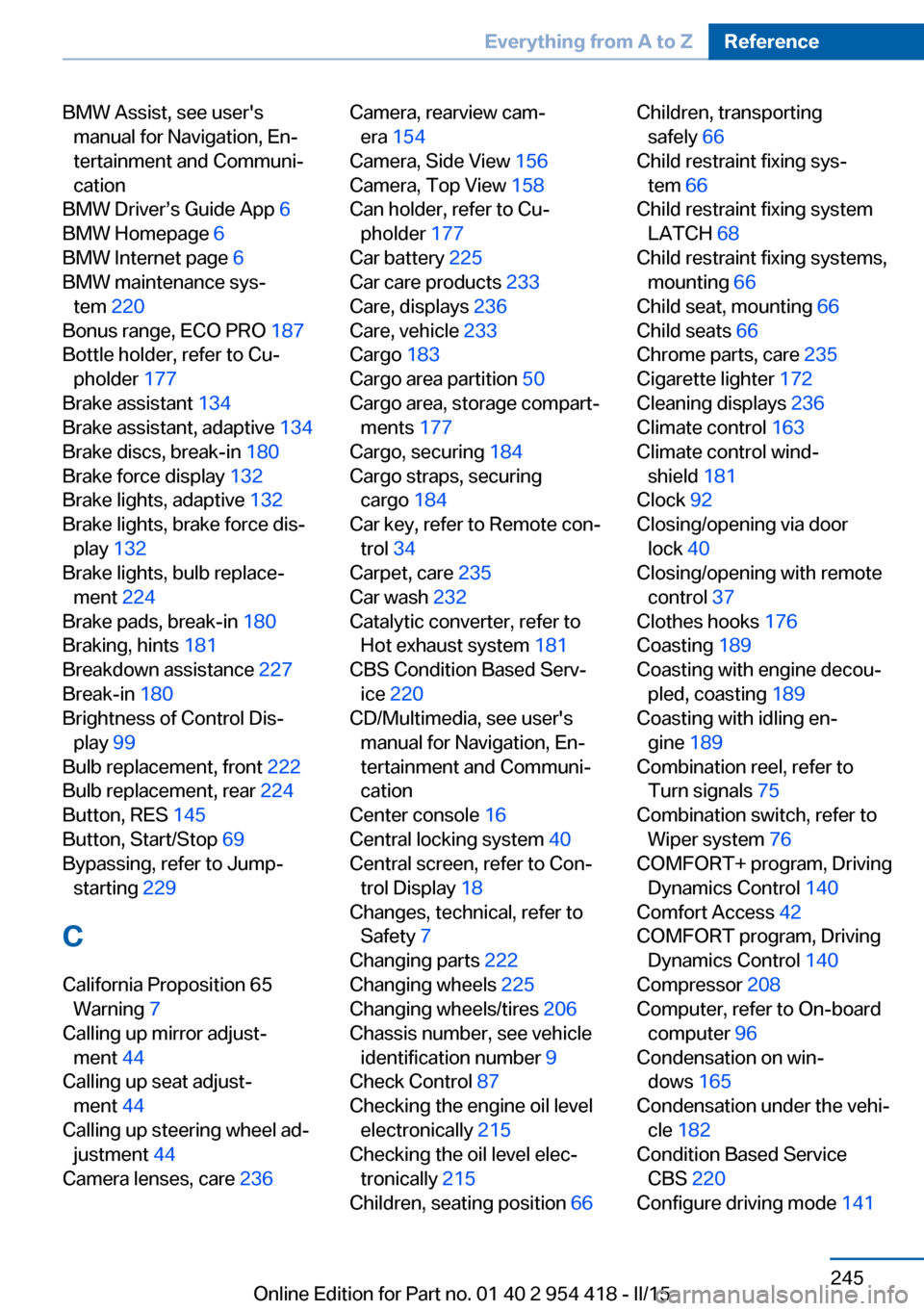
BMW Assist, see user'smanual for Navigation, En‐
tertainment and Communi‐
cation
BMW Driver’s Guide App 6
BMW Homepage 6
BMW Internet page 6
BMW maintenance sys‐ tem 220
Bonus range, ECO PRO 187
Bottle holder, refer to Cu‐ pholder 177
Brake assistant 134
Brake assistant, adaptive 134
Brake discs, break-in 180
Brake force display 132
Brake lights, adaptive 132
Brake lights, brake force dis‐ play 132
Brake lights, bulb replace‐ ment 224
Brake pads, break-in 180
Braking, hints 181
Breakdown assistance 227
Break-in 180
Brightness of Control Dis‐ play 99
Bulb replacement, front 222
Bulb replacement, rear 224
Button, RES 145
Button, Start/Stop 69
Bypassing, refer to Jump- starting 229
C
California Proposition 65 Warning 7
Calling up mirror adjust‐ ment 44
Calling up seat adjust‐ ment 44
Calling up steering wheel ad‐ justment 44
Camera lenses, care 236 Camera, rearview cam‐
era 154
Camera, Side View 156
Camera, Top View 158
Can holder, refer to Cu‐ pholder 177
Car battery 225
Car care products 233
Care, displays 236
Care, vehicle 233
Cargo 183
Cargo area partition 50
Cargo area, storage compart‐ ments 177
Cargo, securing 184
Cargo straps, securing cargo 184
Car key, refer to Remote con‐ trol 34
Carpet, care 235
Car wash 232
Catalytic converter, refer to Hot exhaust system 181
CBS Condition Based Serv‐ ice 220
CD/Multimedia, see user's manual for Navigation, En‐
tertainment and Communi‐
cation
Center console 16
Central locking system 40
Central screen, refer to Con‐ trol Display 18
Changes, technical, refer to Safety 7
Changing parts 222
Changing wheels 225
Changing wheels/tires 206
Chassis number, see vehicle identification number 9
Check Control 87
Checking the engine oil level electronically 215
Checking the oil level elec‐ tronically 215
Children, seating position 66 Children, transporting
safely 66
Child restraint fixing sys‐ tem 66
Child restraint fixing system LATCH 68
Child restraint fixing systems, mounting 66
Child seat, mounting 66
Child seats 66
Chrome parts, care 235
Cigarette lighter 172
Cleaning displays 236
Climate control 163
Climate control wind‐ shield 181
Clock 92
Closing/opening via door lock 40
Closing/opening with remote control 37
Clothes hooks 176
Coasting 189
Coasting with engine decou‐ pled, coasting 189
Coasting with idling en‐ gine 189
Combination reel, refer to Turn signals 75
Combination switch, refer to Wiper system 76
COMFORT+ program, Driving Dynamics Control 140
Comfort Access 42
COMFORT program, Driving Dynamics Control 140
Compressor 208
Computer, refer to On-board computer 96
Condensation on win‐ dows 165
Condensation under the vehi‐ cle 182
Condition Based Service CBS 220
Configure driving mode 141 Seite 245Everything from A to ZReference245
Online Edition for Part no. 01 40 2 954 418 - II/15
Page 251 of 259
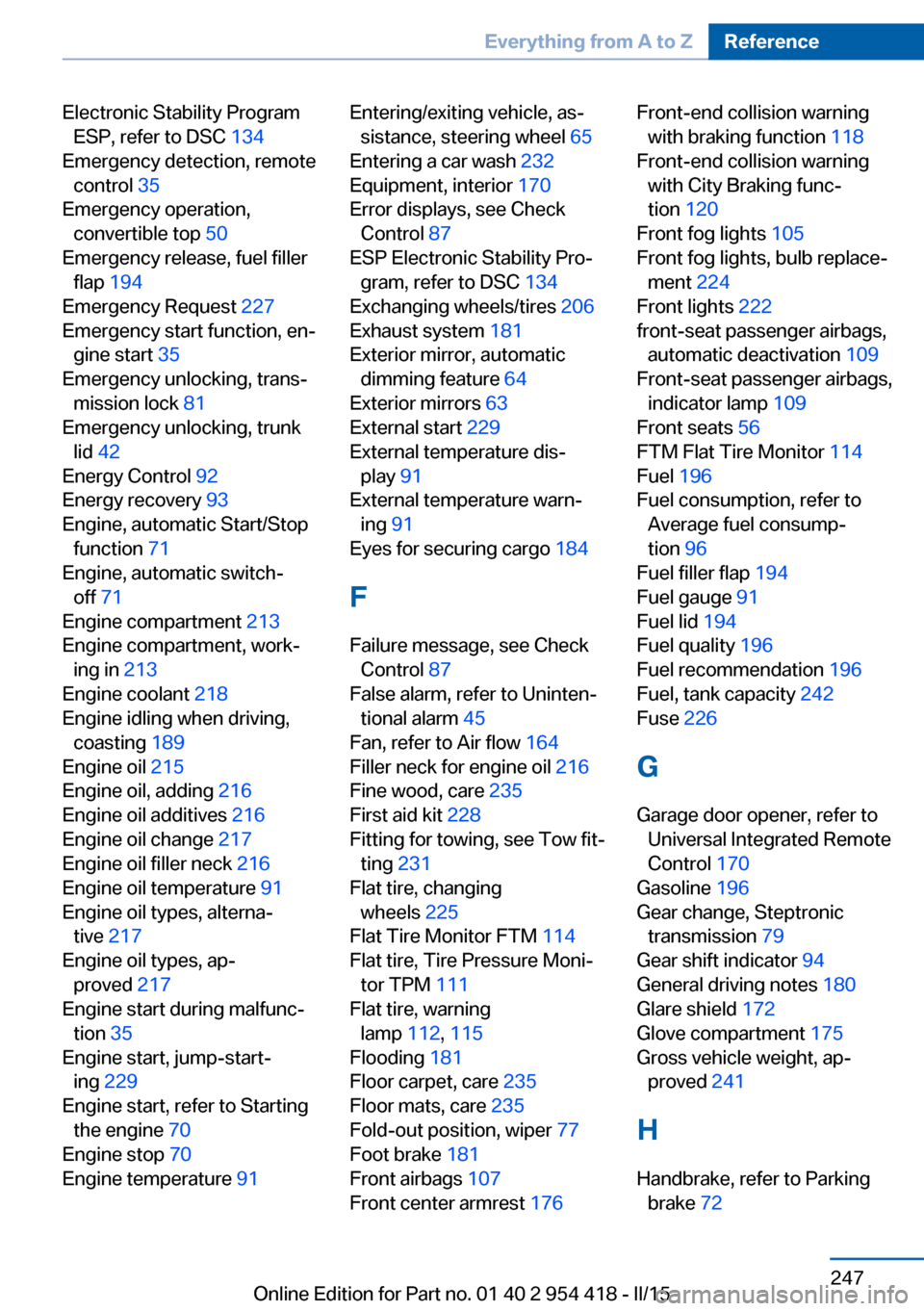
Electronic Stability ProgramESP, refer to DSC 134
Emergency detection, remote control 35
Emergency operation, convertible top 50
Emergency release, fuel filler flap 194
Emergency Request 227
Emergency start function, en‐ gine start 35
Emergency unlocking, trans‐ mission lock 81
Emergency unlocking, trunk lid 42
Energy Control 92
Energy recovery 93
Engine, automatic Start/Stop function 71
Engine, automatic switch- off 71
Engine compartment 213
Engine compartment, work‐ ing in 213
Engine coolant 218
Engine idling when driving, coasting 189
Engine oil 215
Engine oil, adding 216
Engine oil additives 216
Engine oil change 217
Engine oil filler neck 216
Engine oil temperature 91
Engine oil types, alterna‐ tive 217
Engine oil types, ap‐ proved 217
Engine start during malfunc‐ tion 35
Engine start, jump-start‐ ing 229
Engine start, refer to Starting the engine 70
Engine stop 70
Engine temperature 91 Entering/exiting vehicle, as‐
sistance, steering wheel 65
Entering a car wash 232
Equipment, interior 170
Error displays, see Check Control 87
ESP Electronic Stability Pro‐ gram, refer to DSC 134
Exchanging wheels/tires 206
Exhaust system 181
Exterior mirror, automatic dimming feature 64
Exterior mirrors 63
External start 229
External temperature dis‐ play 91
External temperature warn‐ ing 91
Eyes for securing cargo 184
F
Failure message, see Check Control 87
False alarm, refer to Uninten‐ tional alarm 45
Fan, refer to Air flow 164
Filler neck for engine oil 216
Fine wood, care 235
First aid kit 228
Fitting for towing, see Tow fit‐ ting 231
Flat tire, changing wheels 225
Flat Tire Monitor FTM 114
Flat tire, Tire Pressure Moni‐ tor TPM 111
Flat tire, warning lamp 112, 115
Flooding 181
Floor carpet, care 235
Floor mats, care 235
Fold-out position, wiper 77
Foot brake 181
Front airbags 107
Front center armrest 176 Front-end collision warning
with braking function 118
Front-end collision warning with City Braking func‐
tion 120
Front fog lights 105
Front fog lights, bulb replace‐ ment 224
Front lights 222
front-seat passenger airbags, automatic deactivation 109
Front-seat passenger airbags, indicator lamp 109
Front seats 56
FTM Flat Tire Monitor 114
Fuel 196
Fuel consumption, refer to Average fuel consump‐
tion 96
Fuel filler flap 194
Fuel gauge 91
Fuel lid 194
Fuel quality 196
Fuel recommendation 196
Fuel, tank capacity 242
Fuse 226
G
Garage door opener, refer to Universal Integrated Remote
Control 170
Gasoline 196
Gear change, Steptronic transmission 79
Gear shift indicator 94
General driving notes 180
Glare shield 172
Glove compartment 175
Gross vehicle weight, ap‐ proved 241
H
Handbrake, refer to Parking brake 72 Seite 247Everything from A to ZReference247
Online Edition for Part no. 01 40 2 954 418 - II/15
Page 253 of 259
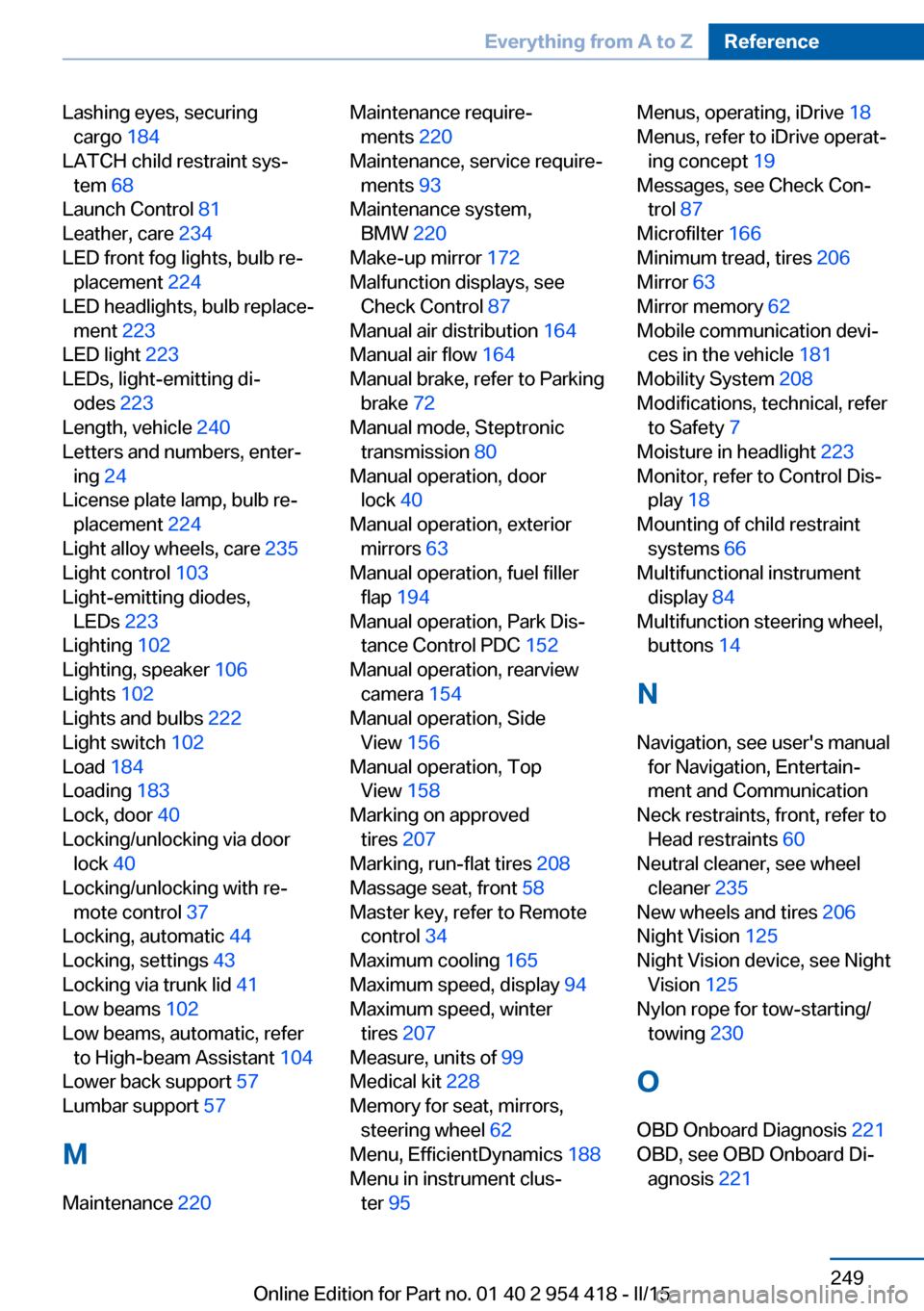
Lashing eyes, securingcargo 184
LATCH child restraint sys‐ tem 68
Launch Control 81
Leather, care 234
LED front fog lights, bulb re‐ placement 224
LED headlights, bulb replace‐ ment 223
LED light 223
LEDs, light-emitting di‐ odes 223
Length, vehicle 240
Letters and numbers, enter‐ ing 24
License plate lamp, bulb re‐ placement 224
Light alloy wheels, care 235
Light control 103
Light-emitting diodes, LEDs 223
Lighting 102
Lighting, speaker 106
Lights 102
Lights and bulbs 222
Light switch 102
Load 184
Loading 183
Lock, door 40
Locking/unlocking via door lock 40
Locking/unlocking with re‐ mote control 37
Locking, automatic 44
Locking, settings 43
Locking via trunk lid 41
Low beams 102
Low beams, automatic, refer to High-beam Assistant 104
Lower back support 57
Lumbar support 57
M
Maintenance 220 Maintenance require‐
ments 220
Maintenance, service require‐ ments 93
Maintenance system, BMW 220
Make-up mirror 172
Malfunction displays, see Check Control 87
Manual air distribution 164
Manual air flow 164
Manual brake, refer to Parking brake 72
Manual mode, Steptronic transmission 80
Manual operation, door lock 40
Manual operation, exterior mirrors 63
Manual operation, fuel filler flap 194
Manual operation, Park Dis‐ tance Control PDC 152
Manual operation, rearview camera 154
Manual operation, Side View 156
Manual operation, Top View 158
Marking on approved tires 207
Marking, run-flat tires 208
Massage seat, front 58
Master key, refer to Remote control 34
Maximum cooling 165
Maximum speed, display 94
Maximum speed, winter tires 207
Measure, units of 99
Medical kit 228
Memory for seat, mirrors, steering wheel 62
Menu, EfficientDynamics 188
Menu in instrument clus‐ ter 95 Menus, operating, iDrive 18
Menus, refer to iDrive operat‐ ing concept 19
Messages, see Check Con‐ trol 87
Microfilter 166
Minimum tread, tires 206
Mirror 63
Mirror memory 62
Mobile communication devi‐ ces in the vehicle 181
Mobility System 208
Modifications, technical, refer to Safety 7
Moisture in headlight 223
Monitor, refer to Control Dis‐ play 18
Mounting of child restraint systems 66
Multifunctional instrument display 84
Multifunction steering wheel, buttons 14
N Navigation, see user's manual for Navigation, Entertain‐
ment and Communication
Neck restraints, front, refer to Head restraints 60
Neutral cleaner, see wheel cleaner 235
New wheels and tires 206
Night Vision 125
Night Vision device, see Night Vision 125
Nylon rope for tow-starting/ towing 230
O OBD Onboard Diagnosis 221
OBD, see OBD Onboard Di‐ agnosis 221 Seite 249Everything from A to ZReference249
Online Edition for Part no. 01 40 2 954 418 - II/15
Page 254 of 259
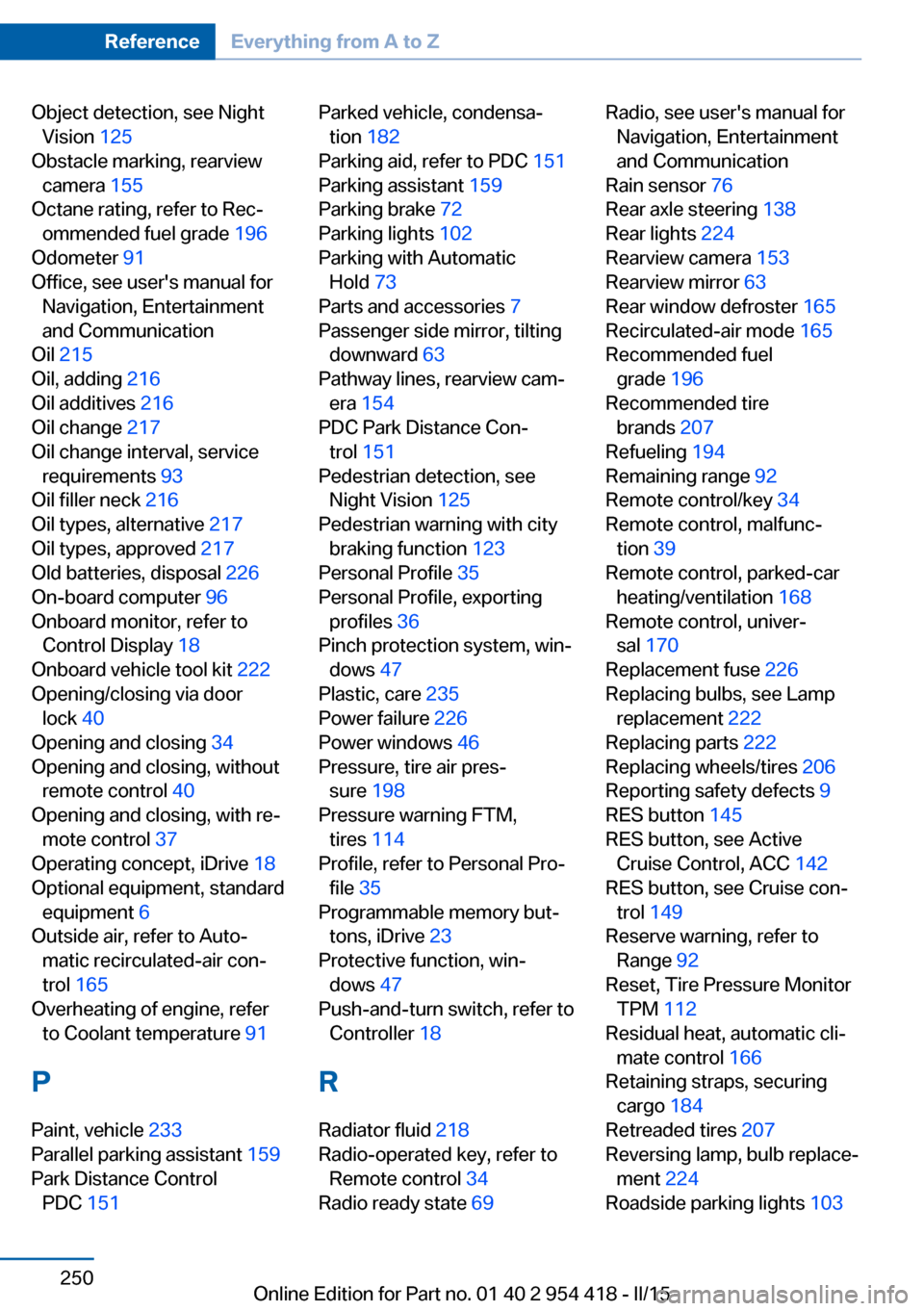
Object detection, see NightVision 125
Obstacle marking, rearview camera 155
Octane rating, refer to Rec‐ ommended fuel grade 196
Odometer 91
Office, see user's manual for Navigation, Entertainment
and Communication
Oil 215
Oil, adding 216
Oil additives 216
Oil change 217
Oil change interval, service requirements 93
Oil filler neck 216
Oil types, alternative 217
Oil types, approved 217
Old batteries, disposal 226
On-board computer 96
Onboard monitor, refer to Control Display 18
Onboard vehicle tool kit 222
Opening/closing via door lock 40
Opening and closing 34
Opening and closing, without remote control 40
Opening and closing, with re‐ mote control 37
Operating concept, iDrive 18
Optional equipment, standard equipment 6
Outside air, refer to Auto‐ matic recirculated-air con‐
trol 165
Overheating of engine, refer to Coolant temperature 91
P Paint, vehicle 233
Parallel parking assistant 159
Park Distance Control PDC 151 Parked vehicle, condensa‐
tion 182
Parking aid, refer to PDC 151
Parking assistant 159
Parking brake 72
Parking lights 102
Parking with Automatic Hold 73
Parts and accessories 7
Passenger side mirror, tilting downward 63
Pathway lines, rearview cam‐ era 154
PDC Park Distance Con‐ trol 151
Pedestrian detection, see Night Vision 125
Pedestrian warning with city braking function 123
Personal Profile 35
Personal Profile, exporting profiles 36
Pinch protection system, win‐ dows 47
Plastic, care 235
Power failure 226
Power windows 46
Pressure, tire air pres‐ sure 198
Pressure warning FTM, tires 114
Profile, refer to Personal Pro‐ file 35
Programmable memory but‐ tons, iDrive 23
Protective function, win‐ dows 47
Push-and-turn switch, refer to Controller 18
R Radiator fluid 218
Radio-operated key, refer to Remote control 34
Radio ready state 69 Radio, see user's manual for
Navigation, Entertainment
and Communication
Rain sensor 76
Rear axle steering 138
Rear lights 224
Rearview camera 153
Rearview mirror 63
Rear window defroster 165
Recirculated-air mode 165
Recommended fuel grade 196
Recommended tire brands 207
Refueling 194
Remaining range 92
Remote control/key 34
Remote control, malfunc‐ tion 39
Remote control, parked-car heating/ventilation 168
Remote control, univer‐ sal 170
Replacement fuse 226
Replacing bulbs, see Lamp replacement 222
Replacing parts 222
Replacing wheels/tires 206
Reporting safety defects 9
RES button 145
RES button, see Active Cruise Control, ACC 142
RES button, see Cruise con‐ trol 149
Reserve warning, refer to Range 92
Reset, Tire Pressure Monitor TPM 112
Residual heat, automatic cli‐ mate control 166
Retaining straps, securing cargo 184
Retreaded tires 207
Reversing lamp, bulb replace‐ ment 224
Roadside parking lights 103 Seite 250ReferenceEverything from A to Z250
Online Edition for Part no. 01 40 2 954 418 - II/15